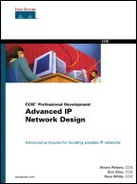O–P
- octet.
A group of eight binary digits; an octet can represent the numbers 0 to 255 in decimal.
- OSI model.
The seven-layer model for designing network protocols.
- partial mesh.
A network where each router has only one connection to a subset of all the other routers in the network.
- passive.
The state of a route in EIGRP when the router has a successor through which to forward packets.
- passive interface.
An interface on which the protocol is not running, although the link itself is advertised as reachable by the routing protocol.
- PAT. Port Address Translation.
Translating source and destination address at the port level, which allows multiplexing many sessions from different hosts onto a single address. Commonly used to permit privately addressed hosts to access servers on the Internet using registered addresses.
- peer group.
A group of BGP neighbors that are treated the same; a BGP router only builds one update per peer group if they are configured, rather than one update per neighbor.
- permanent virtual circuit
- See [PVC. permanent virtual circuit. A permanent virtual (or multiplexed) point-to-point link; common in Frame Relay, X.25, and ATM networks.]
- physical layer
The physical plant, cables, and modulation methods used to transmit data in a network.
- policy routing
Routing packets based on some criteria other than the destination address; choosing different paths for QoS purposes isn't generally considered policy routing.
- pop.
The act of removing a label from the top of the MPLS label stack.
- Port Address Translation.
- See [PAT. Port Address Translation. Translating source and destination address at the port level, which allows multiplexing many sessions from different hosts onto a single address. Commonly used to permit privately addressed hosts to access servers on the Internet using registered addresses.]
- prefix length.
The number of bits in the subnet mask; for instance, the subnet mask 255.255.255.0 has 24 bits set to 1 and is, therefore, a 24-bit subnet mask. The prefix length is often expressed with "/x" after the IP address.
- presentation layer.
The layer in the OSI network model that is responsible for presenting data in an appropriate format to the devices that are communicating.
- private address.
Address or range of addresses defined by the IETF as unusable (unroutable) on the Internet.
- pseudonode.
A mechanism used in IS-IS to reduce the full mesh adjacency normally required on broadcast networks.
- push.
The act of putting a new label on the top of an MPLS label stack.
- PVC. permanent virtual circuit.
A permanent virtual (or multiplexed) point-to-point link; common in Frame Relay, X.25, and ATM networks.
